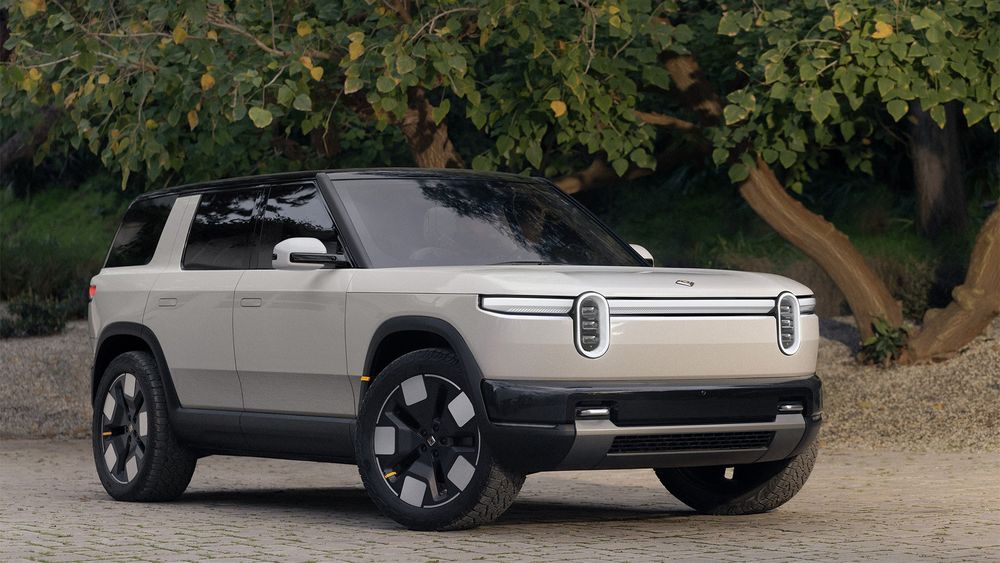Rivian’s third passenger vehicle, the R2 SUV, has finally debuted. It follows the successful launches of the all-electric R1S SUV and R1T pickup truck, two upscale off-road-focused lifestyle vehicles that the R2 clearly is trying to emulate in a smaller scale.
In most respects, the 2026 Rivian R2 resembles a shrunken-down R1S, right down to its similar pill-shaped LED headlights, full-width front and rear light bars, smooth flanks, and chunky stance. No question, the R2 has the Rivian look down pat. At 185.6 inches long, 66.9 inches tall, and with its 115.5-inch wheelbase, the R2 is appreciably smaller than the 200.8-inch-long, 79.3-inch-tall R1S, which rides on a longer 121.1-inch wheelbase. For context, the R2 is slightly smaller than a two-row Jeep Grand Cherokee.

It has neat features, too, including a roll-down rear window like that on the Toyota 4Runner, which retracts into the tailgate. The rear quarter windows also pop out, reminiscent of old minivan quarter glass. Additionally, the dashboard enhances storage with not just one, but two drop-down glove boxes under the dash, surpassing the glove box-less R1S and R1T.
The major differences between it and the R1 models lie beneath its familiar boxy shell. A new R2 platform debuts here, featuring a host of efficiencies learned from the R1 models already available. The changes are said to keep the R2’s cost down, a critical goal for smaller, more affordable electric vehicles packed with sophisticated technology. This focus on affordability is essential for Rivian, which has been navigating financial challenges while seeing those losses shrink rapidly.

The R1s offer dual- and quad-motor configurations, but the R2 will present single-motor rear-drive, dual-motor all-wheel drive, and tri-motor all-wheel drive, with two motors on the rear axle and one on the front. Rivian claims the tri-motor R2 can reach 60 mph in under three seconds. These motors are powered by a structural battery pack that forms the R2’s floor, with Rivian asserting that every motor configuration will provide over 300 miles of driving range.
Trading Ultimate Off-Road Capability for Affordability
The R1T and R1S off-road capabilities are the main drivers of Rivian’s “adventure” branding, although the R2 does not quite follow suit. That said, the R2 still possesses off-road capability but is limited compared to the R1 platform to maintain cost efficiency. If the R1 serves as an off-road pro athlete, the R2 acts more like a semi-pro, a player still honing its skills.
During a Q&A session after the big reveal, Rivian chief design officer Jeff Hammoud confirmed that the R2 will feature approximately 9.8 inches of ground clearance with a 25-degree approach angle and a 27-degree rear departure angle. Unlike the R1’s air suspension system with multiple height settings, the R2 will employ a more conventional coilover setup, complemented by passive anti-roll bars and dampers with a degree of semi-active functionality, as noted by Rivian CEO RJ Scaringe.


The Steering Wheel Controls Sound Awesome
Upon entering the Rivian R2, one of the first features that caught our attention was its steering wheel. While the design has a familiar feel—similar to the R1 models—the standout elements are the two large, vertically oriented dials on each spoke.
These dials do much more than just look attractive; they can be pushed from the front, pulled toward the driver from behind (like shift paddles), and moved side to side while scrolling up and down. Their most impressive feature is the contextual haptics. Similar to the triggers on a Sony PS5 controller, the dials on the R2 steering wheel offer various levels of haptic feedback depending on the feature accessed in the user interface.
For instance, when adjusting the audio volume, the dials emit small clicks, while altering settings like air conditioning fan levels generates more pronounced clicking sensations. When reaching the top of a menu, the dials will “stop” distinctly, relying solely on haptic motors.

Look for the Rivian R2 to go on sale in the first half of 2026. Construction of the factory for assembly is set to begin in early 2024, though Rivian will initially manufacture the R2 at its existing Normal, Illinois, plant while preparing the new facility.
Pricing will be competitive, aiming for a starting MSRP under $50,000—specifically, Rivian states it will cost $45,000 to start. (The R1S begins in the mid-$70,000 range.) This MSRP places it in direct competition with Tesla’s more street-focused Model Y. The R2 is reported to achieve up to 330 miles of range, although details about which battery configuration yields that figure remain pending. Expect lower-priced versions to have diminished range due to smaller batteries, similar to other models in the Rivian lineup.




